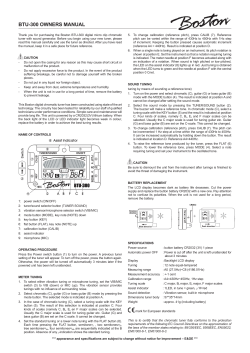
THE ORIGINAL WENCH ® Double-Reed Duck Call
THE ORIGINAL WENCH® Double-Reed Duck Call U.S. Patent Nos. 5,910,039 & 6,234,859 • Double-Reed • Tuning Hole Varies Pitch • Features “Tone Ridges™” & “Tuning Ditches™” All Wench calls feature “Tone Ridges ” and “Tuning Ditches ” on the sounding board which gives the calls their raspy highs and lows and keeps the calls from sticking. In addition to “Tone Ridges ” and “Tuning Ditches ”, the Original Wench features a tuning hole in the bell or stopper, which allows you to change the pitch of the call and sound like two different ducks. Covered, the call is lower in pitch and uncovered, it is higher. Perfect for timber and open-water calling. ® Speak The Language , ® TM TM TM TM ® Will Primos IMPORTANT: Please read all instructions and warnings before using this product to ensure safe and proper use. INSTRUCTIONS & EXERCISES HOLDING THE CALL - Use your thumb and index finger to hold the call where the barrel and the bell join. Fold your fourth and fifth fingers flat against the palm of your hand. Open and close your index and middle fingers over the end of the call to help define each note. Imagine that the call is the duck’s voice and your hand is the duck’s mouth. TUNING HOLE - The tuning hole is located on the bell or stopper. Covered, the call is lower in pitch, uncovered it is higher. Perfect for timber or open-water calling and sounding like two ducks. CONTROL AIR PRESSURE - Place the call to the outside of your lips. Keep lips and cheeks tight. Take a deep breath and hold it in your lungs with your mouth open.Your throat keeps the air from escaping. Now, put air into the call just like you expel air when you whisper loudly forming the sound,”UT”. Quack - The building block for all mallard hen calls is the quack. Use the quack when ducks are approaching your position. Make single notes saying “Ut”. Vary length and pitch. Feed Call - It shows contentment.When the ducks are close, make a series of very short, irregular calls, saying, “dut, dut, dut-a, dut dut-a, dut, dut”. Contented Hen - Use this when ducks are close and circling your decoys. Make four to six calls saying, “Uuuut, uuuut, uuut, uut, uut, ut”. The first three notes should be longer than the last two or three. Taper the volume of each note. Excited Call - Make six to eight excited, fast, demanding quacks with the same cadence and pitch throughout the sequence. “Uuut, uut, uut, uut, ut, ut, ut”. Come Back Call - In a pleading manner, make four to five notes with each note being shorter and softer than the one before. Say, “Uuuuuut, uuuuuut, uuuuut, uuuut, uuut, uut”. The pitch is high to medium and the rhythm is slow and deliberate. REASSEMBLY: Notice the dimple in the top reed. The dimple is pointing down. Notice the black line on the bottom reed; the black line should be facing up. This configuration forms a shape. Look closely, the curves are hard to see. Diagram 1 Dimple Reed Sequence Tuning Ditches ™ Curve Tone Ridges ™ NOTE: The pitch is higher and requires less air when the reeds are pushed back so the pin is touching the front edge of the notch. Diagram 2 VISIT OUR WEBSITE AT PRIMOS.COM WARNING: Primos® game calls are so accurate that you might attract other hunters, as well as game. The user of this product assumes all risk of injury in association with the use of this product. LIFETIME SERVICE GUARANTEE: All Primos game calls come with a Limited Lifetime Service Guarantee. For warranty or service information, email service@ primos.com or call customer service at (601) 879-9323. ® Model No. 820 Made in U.S.A. Primos Hunting 604 First St., Flora, MS 39071 ®
© Copyright 2025





















